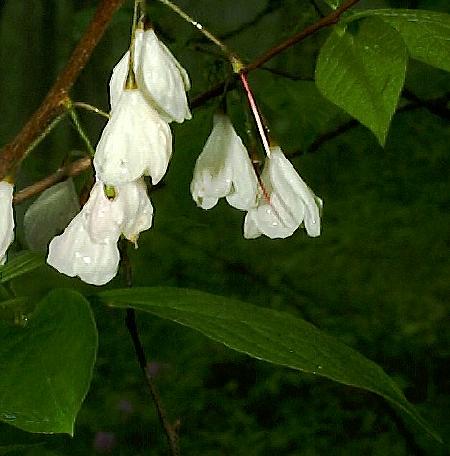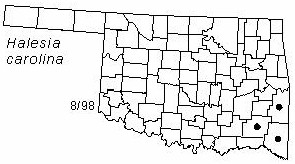

Shrub or tree, usually smaller than 8 m (25 ft) but can grow to 12 m (40 ft) tall and 45 cm (18 in) in diameter. Crown rounded and irregular; with spreading branches. Bark red-brown, scaly. Twigs orange-brown to red-brown, slender, terete and pithy, densely pubescent when young, becoming glabrous with age. Leaves alternate, simple, elliptic, oblong to obovate, stellate-pubescent above, tomentose beneath when young. Mature leaves glabrous, or villose on veins, dark yellow-green above, paler beneath, 10-17 cm (4-6.7 in) long and 4-10 cm (1.6-4 in) wide, rounded to cuneate at base, acuminate at apex, dentate, turning dark yellow-green above, paler beneath in fall. Flowers in fascicles, pedicels long, slender and villose, 1-5 flowers per inflorescence, 15-25 mm (0.6-1 in) long, calyx obconic and four-ribbed, 4-lobed, white, campanulate, contracted into a stigmatic apex, stamens 8-16; flowers appear March to May. Fruits drupes, 4-winged, 2.5-5 cm (1-2 in) long, 1.2-1.8 cm (0.5-0.8 in) in diameter, ellipsoid to obovoid, 2-3 seeds, maturing in Autumn.
Distribution: eastern Okahoma, Texas, and Arkansas, east to northwest Florida, north to Virginia, and west to Illinois and Missouri. Uncommon in Oklahoma; restricted to the Ouachita Mountains.
Habitat: moist, well-drained soils on floodplains and mesic forest.
NWI status: none
Comments: named in honor of Stephen Hales (1677-1761), English clergyman and author of "Vegetable Staticks"; carolina refers to the state of origin of the first described collection.
Horticulture: Silverbell has been cultivated as an ornamental since 1756. It has been more popular in European gardens than here in the United States. Silverbells can be propagated by layering, root cuttings, or green wood cuttings. It also stump sprouts.
Economic use: Silverbell rarely reaches sawtimber size. When trees are cut, they are used for cabinetry and paneling.
Distribution in Oklahoma: 
BACK
NEXT
RETURN TO INDEX
Last update: 9/10/99
 Go to Oklahoma Biological Survey Home Page
Go to Oklahoma Biological Survey Home Page
 Disclaimer
Disclaimer